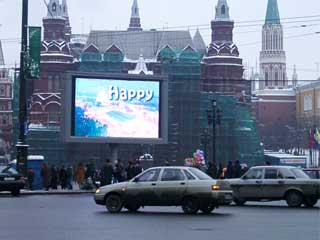Outdoor advertizing display screens and traffic hazards
For several weeks we have closely followed a discussion in Russian local media and Internet sites devoted to outdoor advertising. The discussion was sparked by the appearance of huge digital lamp screens in several Russian cities assembled by “ATV Outdoor Systems”, long-time player in the electronic media market. A few critical reviews concerned not the advertising potential of large digital outdoor screens or the content of commercials, or financial feasibility but questioned the very concept of commercial advertising along roads.
Curiously, we have received several E-mails from Costa-Rica, Spain, and Dubai asking for expert opinion on the effect of digital outdoor advertising on traffic situation and safety. Therefore we felt it imperative to write this article with comments and background information. Traffic situation is bad everywhere. Too many people, too many children, too many cars – that accurately describes any large city. Emergencies, state visits, road repairs, bad weather make this situation even worse. Who is to blame? Typically, people start searching for a scapegoat. And find it at once: outdoor advertising is responsible for it all.
 |
 |
| Giant outdoor advertizing screen near Kremlin in Moscow | Large advertizing LED screen in San Paolo |
In the 20th century life has been changing fast. Technological advance brought revolutionary changes to our way and style of life. Many people would remember the times when there was practically no advertising, indoor or outdoor, TV or radio, no mail advertising, no advertising as a genre. Since then the situation has changed drastically giving a lot of people the reason to complain. Life was manageable without advertising; why do we need it now?
 |
 |
| Large outdoor advertizing screen in Tokyo | Digital outdoor advertizing in New York |
Typically, advertising in city streets means additional revenue to city budgets, lively business in the neighborhood, cleaner and brighter environment. To some cities this also translates into better city image, well lit streets and additional tourism. No doubt, advertising must be carefully controlled, not to turn streets into uniform tunnels of advertising boards. However, this never happens. In fact, outdoor advertizing display screens indirectly help to reduce the number of boards in the vicinity; no static image bears comparison with animated commercial.
Practically everywhere in the world the electronic (digital) advertising is widely spread and new technological solutions are welcomed and promoted. Outdoor advertising budgets are comparable with budgets on TV advertising. That brings about additional financial flows, investments, business and new work places. Cities spend advertising money on keeping their streets clean, lit and well paved. In fact, cities become addicted to outdoor advertising as a means of constant income. So, the question is: should be outlaw outdoor advertising? Will that make traffic safer? There are no indications that it will. (Similar arguments raged around the topic of car stereos not too long ago).
In short spells that we are not driving but walking around cities, advertising is not a annoying but a welcome distracting factor. After all it does provide information, useful or not, in time periods when we are not preoccupied with other things.
Naturally, modern driver is subject to numerous stresses. With heavy city traffic driver’s attention must be glued to the road. But the driver is obligated to pay attention to numerous road and informational signs that are lit in the evening time. Thus, any driver gets used to seeing everything, focusing on what’s essential and disregarding what’s not. Advertising, including outdoor digital screens and displays, remains in the peripheral vision, unless a driver finds himself in a traffic jam with some time to spare.
During such “empty” periods absorbing new information has a positive effect. It creates a much needed distraction from a monotonous movement. (Traffic police in many countries has repeatedly warned drivers from losing concentration after long time driving). Still more traffic accidents occur from inattentive driving every year. Thus, outdoor advertizing display screens have their positive effect.
The number of outdoor screens around the world is steadily growing: New York – 20, Chicago – 60, Las Vegas – 100, Seoul – 90, San Paolo – 50, Tokyo – 50, London – 7, Moscow – 7. Even the conservative Europe has recognized the advantages of electronic (digital) outdoor advertising; displays and screens are being installed there regularly. Similar to neon signs, outdoor advertizing screens are bright and are better seen – therefore, screens are winners! To try and stop the trend is unreasonable, especially for those who know how to make business and attract investments.
In London’s National Gallery I have seen a wonderful painting by Richard Wilson (1713-1782) “Westminster Bridge under construction”. The painting shows the bridge during the period of its construction in 1744. Guides provide an interesting insight into its history. The bridge was constructed very slowly. At that time London had only one bridge across Thames – London Bridge. The growing city urgently needed another. But quite unexpectedly, builders and city authorities ran up against heavy resistance of ferry operators who had feared that the bridge would put them all out of work. The bridge was constructed – and has been serving the city and its people since then.
The outdoor advertizing screens and displays will continue to be build and installed around the world. Digital outdoor screens are symbols of new developments and changes for the better. The trend is unstoppable.





